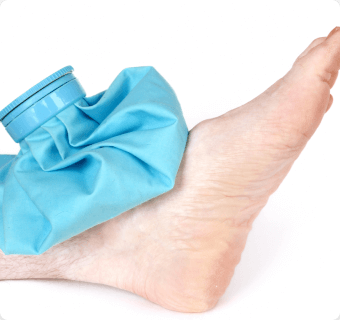Initial simple treatments can provide some pain limited relief
The first step in treating Morton’s neuroma is to use conservative or non-medical methods to attempt to relieve the pain. In many cases, conservative treatment may result in some pain relief in the early stages of Morton’s neuroma where the pain is mild but unfortunately this relief may only be temporary . In other words, in most cases, these methods will provide some short term pain relief in the early stages of the condition, but these conservative measures will become ineffective fairly soon.

Effect of Ice : The effect of ice on Morton’s neuroma is debatable since Morton’s neuroma is not an inflammatory disease however, Morton’s neuroma often occurs in conjunction with bursitis or epicondylitis and these are inflammatory conditions in which case ice would be helpful. It may be very difficult even impossible to determine whether the pain that you are feeling is from a Morton’s neuroma or an adjacent bursitis or epicondylitis.
How to use Ice : To decrease inflammation, one should use ice on the painful area for 15-20 minutes, at least 2-3 times per day – especially in the evening. (Caution: avoid using ice if you suffer from circulation or sensation problems in the foot.) Applying ice then heat, known as contrast therapy, is another treatment for Morton’s neuroma. This treatment involves alternating between ice packs and heating pads. Typically, an ice pack will be placed on your foot for 15- 20 minutes. Next, the ice will be removed and a heating pad will be placed on your foot for another 15-20 minutes. The contrast between hot and cold will alleviate pressure due to swelling as well as increase blood flow to the affected tissues, which can speed up the healing process.

Importance of Physical Therapy : Physical therapy should not be glossed over as unimportant because often it is an important aid to treat pain, especially as part of more comprehensive plan. Even when other methods, such as medications and surgeries, are used, physical therapy is an important adjunct to help healing and reduction of pain.

A simple way to treat the pain of Morton’s neuroma is through the use of medications. Mortons neuroma pain is primarily a pain that arises from the nerve, and this means that many medications are available to treat the pain. Although pain medications on their own are not often as effective as combination treatments, they can help to reduce pain enough to facilitate physical therapy and exercise.
Acetaminophen is often used for the relief of mild to moderate pain associated with many conditions, including Morton’s neuroma. Unless directed by a physician, acetaminophen should not be used for longer than 10 days. When used appropriately, side effects with acetaminophen are not common. The most serious side effect is liver damage due to large doses, chronic use or taking Tylenol with alcohol or other drugs that also damage the liver. You should keep your dose below 3000 mg per day. If you drink alcohol regularly do not take Acetaminophen. In any event, you should consult your physician. For more information on Acetaminophen (Tylenol) click here.
Like Tylenol, non-steroidal anti-inflammatory drugs, or NSAID are recommended early in the presentation because they are effective with relatively few side effects. The most common NSAIDs are the over the counter pain medications Advil and Aleve. However, they are not the only NSAIDs available to a practitioner. Certain advanced NSAIDs called COX-2 inhibitors, such as Celebrex, can be prescribed. They are less likely to cause stomach side effects, such as bleeding ulcers, but medications in this class have been linked to cardiac side effects. For this reason, they are used with caution. In addition, long term use of NSAIDs can use kidney damage and bleeds in the gastrointestinal track and should be avoided. Follow these links for more information about the NSAIDs Ibuprofen (Advil) and Naproxen (Naprosyn/Aleve).
In some cases the addition of other medications may be helpful in controlling pain due to Morton’s neuroma.Besides Tylenol and NSAID’s, tricyclic antidepressants such as amitriptyline, can be used to control nerve pain. Recent studies have found that these older style antidepressants are very effective in treating any nerve pain, and they can relieve some of the discomfort of Morton’s neuroma. A low dose can help with the burning in the toes.The antidepressant Duloxetine or Cymbalta is another of the antidepressants that has proven useful in the treatment of nerve pain. In fact, the FDA recently approved it as a treatment for chronic pain, and it can help with Morton’s neuroma if other medications are ineffective.
Some anticonvulsant medications such as Gabapentin or Lyrica, can help with the nerve pain from Morton’s neuroma. While the exact mechanism of action is unknown these medication are effective. Recently, the FDA approved Lyrica for use in diabetic peripheral neuropathy and post-herpetic neuralgia, but Lyrica can also help with the nerve pain associated with Morton’s neuroma.


By providing us with your information you are consenting to the collection and use of your information in accordance with our Terms of Service and Privacy Policy.